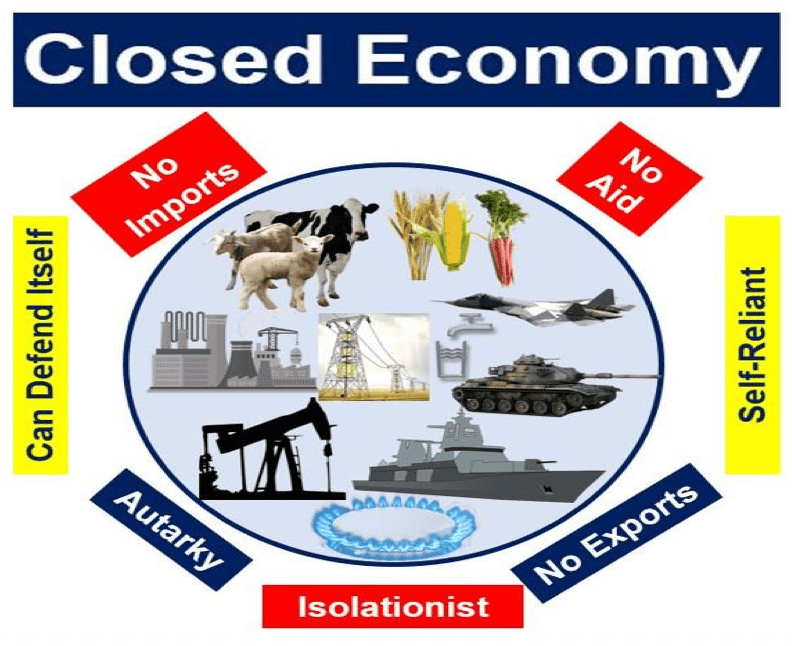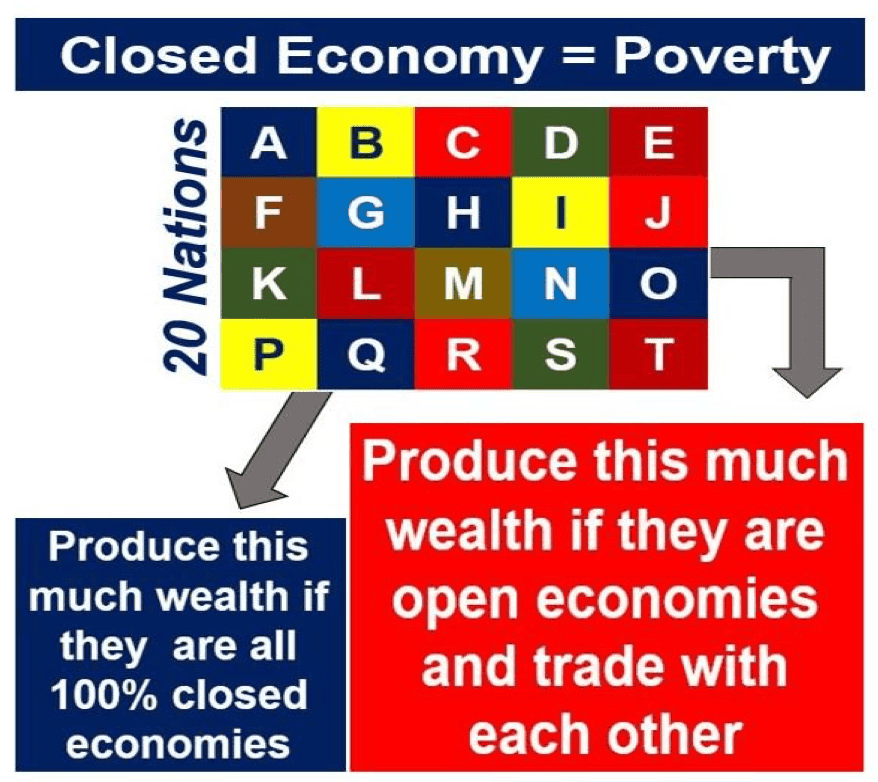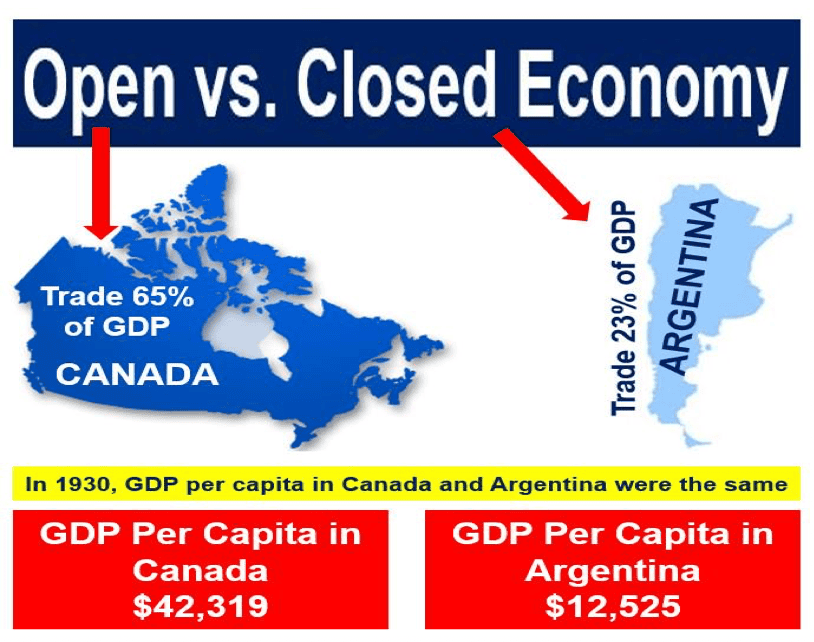A Closed Economy is a country that does not import or export. A closed economy sees itself as self-sufficient and claims it does not want to trade internationally. In fact, it believes it does not need to trade.
In a completely closed economy, there are no imports or exports. The country claims that it produces everything its citizens need. We also refer to this type of economy as isolationist or autarky.
A closed economy is the opposite of an open economy or a free-market economy. Open economies trade with other nations; they import and export goods and services. Hence, we also call them trading nations.
Maintaining a closed economy is more difficult today than two hundred years ago.

Certain raw materials are vital for the production of many products. For example, without oil, a country would not be able to function today. Many countries, such as Japan, need to import nearly all their raw materials.
Cooperation creates wealth
Henry George (1839-1897), an American political economist wrote a book titled ‘Progress and Poverty.’ He published it in 1879. George explained that cities and nations that cooperate with each other are much wealthier than those that don’t.
George’s illustration consisted of a plot of undeveloped, resource-rich land. Twenty people had divided up that land. In other words, they owned one-twentieth each.
By cooperating intelligently, they could produce much more than if they worked in isolation, he explained.
Similarly, twenty nations cooperating intelligently can create more wealth than twenty countries can with no cooperation.

Closed economy utopia is a myth
A closed economy or autarky is not a utopia. Many leaders have eventually found out the hard way. No country has ever been able to produce the full range of products and services its population demands. Additionally, producing all those goods at competitive prices is impossible.
Those who have tried to do so have condemned their systems to inefficiency. Their people lost wealth. Put simply; their countries became poorer while the trading nations got richer.
North Korea is a closed economy compared to South Korea. Sixty years ago both countries were extremely poor. South Korea has traded internationally. North Korea, on the other hand, has traded very little. South Korea is today significantly richer than North Korea.
In a closed economy, citizens find the lack of goods intolerable. Consequently, black markets emerge, which import products from other countries.
And herein lies the myth – the autarky exists only in theory. The closed economy is not closed because the black market is importing goods.
The largest black markets in modern history have flourished in the Soviet Union and its satellite countries. North Korea and Cuba also have huge black markets. All these countries are or were closed economies.
Modern history of closed economies
Dominican Republic
In the Dominican Republic between the 1600s and early 1900s, rural peasants, freed slaves, and escaped slaves lived in total isolation. They lived in the forest deep in the interior of the country.
Japan
In Japan, until the 1850s when it opened to the west, it was a partial autarky. We call that period of isolationism the Edo Period. In Japan, people call it Sakoku (鎖国).

The Great Empires
The empires of the 17th and 19th centuries pursued a policy of mercantilism. This meant that there was very little trade outside the empire.
The United States
US President Thomas Jefferson, in 1808, declared a self-imposed embargo on all shipping from abroad. This embargo lasted until 1809. The US was emerging from the American Revolution and feared the economic and military might of Great Britain.
Nazi Germany
In the 1930s, Adolph Hitler had a goal of self-sufficiency. The Nazis encouraged trade within its economic bloc but discouraged external trade.
Hitler especially disliked trade with the UK, France and Russia – countries against which he expected to be fighting in a war.
Nazi Germany traded with seemingly economically weak countries that were rich in raw materials. For example, resource-rich Argentina traded with Germany.
India
After its establishment as an independent state in 1950, India pursued a quasi-autarky. This policy continued until 1991.
Albania
In 1976, Enver Hoxha, Albania’s communist leader, turned his country into a quasi-autarky. After he died in 1985, the country began trading again.
Spain
Spain’s dictator, Francisco Franco, severely restricted international trade from 1939 to 1959. After the country started trading with other nations, the Spanish Miracle occurred. The Miracle was a period of rapid economic growth that lasted well into the 1970s.
Burma (Myanmar)
Burma’s dictator, Ne Win, pursued the Burmese Way to Socialism from 1962 to 1988. During that period, it traded as little as possible with other countries. Today, the country’s name is Myanmar.
Romania
Nicolae Ceaușescu, Romania’s dictator, proposed paying off the country’s entire foreign debt and boosting domestic production.
He wanted to reduce dependency on imports. He wanted this because his relationship with both Western and communist leaders had worsened.
South Africa
South Africa had a closed economy forced upon it during the Apartheid period – from 1948 to 1991. The international community imposed economic sanctions.
North Korea
Completely closed economies do not exist anymore. North Korea is the best example today of a nation aiming for total autarky. It is one of the poorest countries in the world.
Without food aid from abroad, millions of North Koreans would not be alive today. Hence, the country is not self-sufficient.
Brazil – the cost of a less open economy
While Brazil is by no means a closed economy, when viewed through the lens of trade penetration, it remains less open than several of its global peers. Data from 2021 indicates that Brazil’s combined exports and imports equaled approximately 39.2% of its GDP. In contrast, an average trade penetration rate of around 55% was observed among countries with larger economies than Brazil.
In its analysis, the World Bank posits potential scenarios for Brazil should it lean into deeper global integration:
“By embracing global value chains more fully, Brazil might see less competitive production segments give way to imports. The remaining domestic businesses, enriched with imported inputs, could potentially manufacture products that are both cost-effective and of superior quality.”
Reflecting on Brazil’s economic trajectory over the past several decades, one can’t help but wonder: Had Brazil been more open to international trade and collaboration, might it now stand among the world’s advanced economies?
Conclusion
The examples in this article illustrate a critical point: while the idea of being completely self-reliant may appeal to notions of national sovereignty and security, in practice, it typically leads to economic stagnation and a relatively low standard of living for the populace.
Countries that embrace international trade not only enrich their own citizens but contribute to the advancement of global prosperity.
Video explantion
